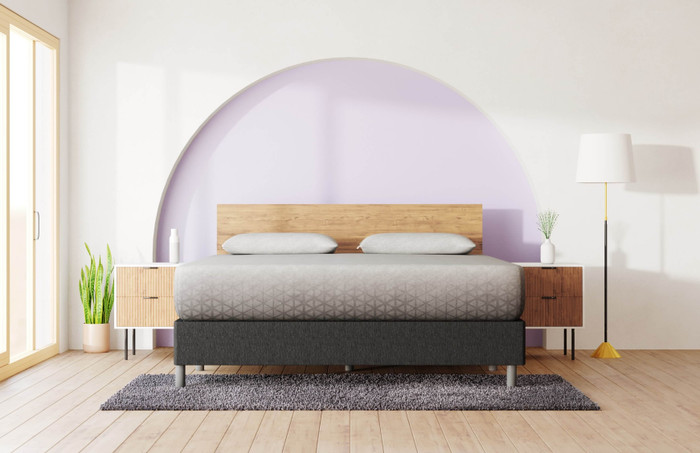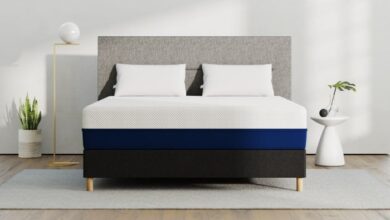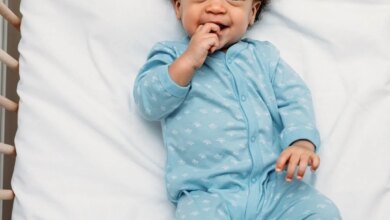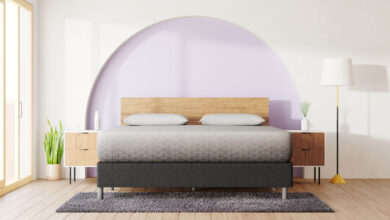Are Antique Cribs Safe for Your Baby?

September 17th, 2025 . 6 mins read
Key Takeaways
- Antique cribs may look charming but often fail modern safety standards—including banned drop-sides, wide slat spacing, and toxic finishes.
- Structural weaknesses and improper mattress fit pose hidden dangers, increasing risks of entrapment, collapse, or suffocation.
- Safer alternatives include modifying the crib with updated materials or repurposing it into furniture like a daybed, bench, or bookshelf rather than using it for infant sleep.
Antique cribs hold a certain charm and nostalgia, making them an appealing choice for parents who appreciate vintage aesthetics. However, while these cribs may be visually stunning, they might not meet modern safety standards.
If you’re considering using an antique crib for your baby, it’s crucial to understand the potential risks and necessary precautions.
Are Antique Cribs Safe
Older cribs often fail to meet modern safety standards, which banned drop-side cribs and enforced stricter regulations on slat spacing, mattress support, and overall crib durability.
These outdated designs can pose serious risks, including structural instability and entrapment hazards.
Without compliance with current safety guidelines, older cribs may lack the reinforced materials and secure fastenings needed to ensure a baby’s safety.
Potential Safety Concerns
1. Drop-Side Mechanisms
One of the most significant dangers of antique cribs is the presence of drop-side railings. These movable sides were designed for convenience, allowing parents to lower one side for easier access to the baby.
However, over time, the mechanisms can weaken, detach, or malfunction, creating gaps that pose serious risks of suffocation or entrapment. Due to these safety hazards, drop-side cribs were officially banned.
Using a crib with this feature, even if it appears functional, is highly discouraged, as it may unexpectedly fail and cause injury.
2. Wider Slat Spacing
Older cribs often have slats that are spaced too far apart, which can be extremely dangerous for infants.
According to modern safety regulations, crib slats should be no more than 2 3/8 inches apart to prevent a baby’s head, arms, or legs from slipping through and getting stuck.
If the slats are too wide, there is a risk of head entrapment, which can lead to suffocation or severe injuries. Measuring the spacing of slats in an antique crib is essential before considering its use for a baby.
3. Lead Paint and Toxic Finishes
If a baby chews on the crib rails or ingests paint chips, lead exposure can lead to developmental delays, neurological damage, and other serious health issues.
Additionally, some older wood finishes may contain toxic chemicals that can be harmful if inhaled or ingested. Even if the crib appears to be in good condition, old paint or varnish should be tested for lead content before use.
Stripping and repainting an antique crib with a non-toxic, baby-safe finish is one way to reduce risk, but professional testing is recommended.
4. Structural Integrity
Time and wear can significantly impact the durability of antique cribs. Wood weakens with age, screws, and bolts may loosen, and joints may become unstable, increasing the risk of collapse.
Even if a crib appears sturdy, hidden weaknesses in the structure could cause it to break under a baby’s weight or movement. Regular inspections for loose parts, splintered wood, or other signs of deterioration are necessary.
However, given the risks involved, it is often safer to opt for a crib that meets current manufacturing standards rather than relying on an older one.
5. Mattress Size and Fit Issues
A properly fitting mattress is crucial for infant safety, as gaps between the mattress and crib frame can create entrapment hazards.
Older cribs may not conform to modern standardized mattress dimensions, leading to spaces where a baby could become stuck or suffocate.
Modern cribs are designed to fit standard-size crib mattresses snugly, reducing these risks. If an antique crib has an irregularly sized mattress area, it may be difficult to find a suitable mattress, increasing the potential danger.
Checking for proper mattress fit is essential before considering the use of an older crib.
6. Lack of Modern Safety Features
Many modern cribs come equipped with safety enhancements such as reinforced hardware, teething rails, and adjustable mattress heights.
Older cribs may lack these essential safety features, increasing the potential for accidents.
Without teething rails, for example, a baby could chew on the wood, increasing the risk of ingesting harmful substances. Additionally, the inability to adjust mattress height can make it easier for an active infant to climb out, leading to falls and injuries.
7. Potential for Hidden Hazards
Antique cribs may have been repaired multiple times, sometimes using non-standard or makeshift hardware that could create safety risks.
Nails, screws, or glue may have been used as quick fixes, but these repairs could weaken over time or introduce choking hazards if small parts become loose.
It is crucial to examine all fasteners and materials to ensure they meet current safety standards.
8. Fire Safety Concerns
Older wooden cribs may have been treated with flammable finishes or varnishes, increasing the risk of fire hazards in the nursery.
Additionally, older mattresses may not meet modern fire-retardant standards, posing further dangers.
Ensuring that both the crib and mattress adhere to contemporary fire safety regulations is an important factor in creating a secure sleeping environment for an infant.
How to Make an Antique Crib Safer?
Antique cribs hold sentimental value and a vintage charm that many parents appreciate, but they often lack modern safety features.
If you’re determined to use an antique crib, taking the right precautions can help make it a safer sleeping space for your baby. Below are essential steps to ensure your crib meets safety standards while preserving its historical appeal.
1. Check for Recalls
Before using an antique crib, research its brand and model to determine if it has ever been recalled. Many older cribs have been deemed unsafe due to design flaws, lead-based paint, or structural weaknesses.
You can check with consumer protection agencies or online databases that list recalled baby products. If your crib has been recalled, it’s best to avoid using it, as it may pose significant safety risks.
2. Secure Drop-Sides
Drop-side cribs were once a common design feature, allowing parents to lower one side for easier access to the baby. However, these cribs have been linked to serious safety hazards, including entrapment and suffocation risks.
If your antique crib has a drop-side, consider permanently securing it in place using brackets, screws, or wood glue. Alternatively, you can replace the drop-side with a solid, fixed panel to eliminate the risk entirely.
3. Measure Slat Spacing
The spacing between crib slats is a crucial safety factor. Modern safety guidelines recommend that slats should be no more than 2 3/8 inches apart to prevent a baby’s head from getting stuck.
Older cribs often have wider gaps, which pose a risk of entrapment. If the slats on your antique crib exceed this spacing, you may need to install additional wooden dowels or reconsider using the crib altogether.
4. Refinish Safely
Many antique cribs were painted with lead-based paint, which can be extremely hazardous to infants. If the paint on your crib is chipping or peeling, strip it carefully using a safe, non-toxic method.
Avoid sanding, as this can release harmful lead dust into the air. Instead, use a chemical stripper specifically designed for lead paint removal.
Once stripped, repaint the crib with a baby-safe, non-toxic paint to ensure your child is not exposed to harmful chemicals.
5. Inspect for Weakness
Over time, antique cribs can develop structural weaknesses due to years of use, storage, or environmental factors. Thoroughly inspect the crib for any loose joints, cracked wood, or missing hardware.
Tighten all screws and bolts to reinforce stability, and replace any broken or missing parts with high-quality replacements. If the crib wobbles or shows signs of weakness even after repairs, it may not be safe for use.
6. Use a Proper Mattress
A well-fitting mattress is essential for crib safety. The mattress should fit snugly against the crib’s frame, leaving no more than a two-finger gap between the mattress and the sides of the crib.
A crib mattress that is too small can create dangerous gaps where a baby could become trapped. Ensure that the mattress is firm, breathable, and meets current safety standards for infant sleep.
Alternative Uses for Antique Cribs
While antique cribs have undeniable charm, safety concerns may make them unsuitable for modern infant sleep.
Instead of discarding a beloved heirloom, consider repurposing it into something practical and stylish. With a bit of creativity, you can give your antique crib a second life as a functional piece in your home.
1. Convert It Into a Stylish Daybed or Bench
One of the easiest and most elegant ways to repurpose an antique crib is by transforming it into a cozy daybed or bench.
By removing one side of the crib and reinforcing the frame, you can create a charming seating area for a nursery, playroom, or even a porch.
Adding plush cushions and decorative throw pillows can enhance comfort and style, making it a beautiful statement piece that preserves the crib’s sentimental value.
2. Use It as a Playpen for Supervised Activities
If the crib remains structurally sound but isn’t safe for unsupervised sleep, consider converting it into a playpen for daytime activities.
By reinforcing the frame and ensuring there are no hazards, the crib can serve as a contained play area where young children can safely engage with toys, puzzles, or art projects.
This setup works particularly well for older infants and toddlers who need a secure space to explore under adult supervision.
3. Transform It into a Bookshelf or Storage Unit
An antique crib can be repurposed into a unique and functional bookshelf or storage unit. By removing one side and adjusting the slats, you can create shelves for books, baskets, or decorative items.
The crib’s frame can also be used as a storage rack for blankets, stuffed animals, or craft supplies.
This transformation is an excellent way to preserve the crib’s aesthetic appeal while adding practical organization to a child’s bedroom or playroom.
Repurposing an antique crib allows you to maintain its nostalgic value while ensuring it remains a functional and stylish part of your home.
Whether turned into seating, storage or play space, these creative alternatives ensure your cherished crib continues to serve a purpose for years to come.
FAQs
Can I Use an Antique Crib as a Family Heirloom?
Yes, an antique crib can be a treasured family heirloom, but using it for a baby requires careful evaluation. Many families choose to keep antique cribs for their sentimental value, passing them down through generations. If the crib isn’t safe for sleep, consider repurposing it into a decorative piece, such as a display for stuffed animals, a plant stand, or a nostalgic focal point in a nursery.
Are There Any Certifications or Testing Available for Antique Cribs?
Unlike modern cribs that must meet CPSC and ASTM safety standards, antique cribs typically do not undergo official safety testing. However, parents can conduct their own safety checks, such as measuring slat spacing, ensuring structural stability, and testing for lead paint. Some companies offer professional lead testing services if you’re concerned about toxic finishes.
Can an Antique Crib Be Used for Short Naps Instead of Overnight Sleep?
Even for short naps, an antique crib may still pose risks if it doesn’t meet current safety standards. Issues like drop-side mechanisms, loose hardware, or mattress gaps don’t just develop overnight—they can be dangerous at any time. If you’re set on using an antique crib occasionally, reinforce weak spots and always supervise your baby closely.
Is It Possible to Find Modern Cribs with a Vintage Look?
Absolutely! Many crib manufacturers design modern cribs with vintage-inspired aesthetics, offering a safer alternative to true antique cribs. These cribs feature decorative details like spindle slats, curved wood panels, and classic finishes while still complying with safety regulations. Opting for a new crib with a vintage design allows you to blend nostalgia with modern safety.
What Should I Do If an Antique Crib Has Been in Storage for Years?
If an antique crib has been stored in an attic, basement, or garage, it’s essential to inspect it thoroughly before use. Look for signs of wood warping, rusted hardware, mold, or pest damage. Additionally, temperature fluctuations over the years may have weakened the structure. A deep cleaning and proper safety modifications are crucial if you plan to repurpose it.
Are There Any DIY Kits to Retrofit Antique Cribs for Safety?
While there are no official “safety retrofit kits” for antique cribs, some parents choose to modify them using baby-safe paint, additional slats, and reinforced hardware. However, these DIY solutions don’t guarantee full compliance with modern safety standards. If you’re unsure about making modifications, consulting a professional woodworker or crib safety expert is a safer approach.
Conclusion
While antique cribs bring beauty and history to a nursery, they often lack the safety features necessary for modern infants. Before using one, thoroughly assess its condition and modify it to meet current safety standards.
If in doubt, it’s always best to opt for a modern crib that adheres to updated regulations, ensuring your baby sleeps safely and soundly.
This article is for informational purposes and should not replace advice from your doctor or other medical professional.


